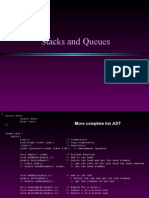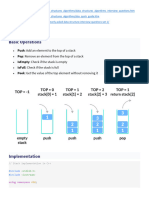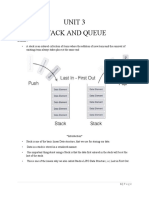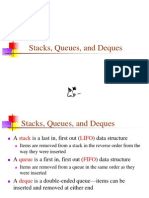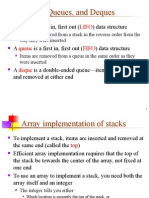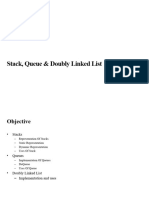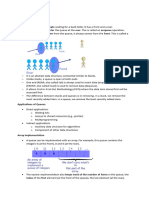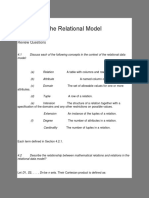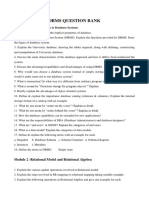COMP171
Fall 2006
Stacks and Queues
�Stack and Queue / Slide 2
Stack Overview
Stack ADT
Basic operations of stack
Pushing, popping etc.
Implementations of stacks using
array
linked list
�Stack and Queue / Slide 3
Stack ADT
A stack is a list in which insertion and deletion take
place at the same end
This end is called top
The other end is called bottom
Stacks are known as LIFO (Last In, First Out) lists.
The last element inserted will be the first to be retrieved
�Stack and Queue / Slide 4
Push and Pop
Primary operations: Push and Pop
Push
Add an element to the top of the stack
Pop
Remove the element at the top of the stack
empty stack push an element push another
top
top
top
pop
B
A
top
�Stack and Queue / Slide 5
Implementation of Stacks
Any list implementation could be used to
implement a stack
Arrays (static: the size of stack is given initially)
Linked lists (dynamic: never become full)
We will explore implementations based on
array and linked list
Lets see how to use an array to implement a
stack first
�Stack and Queue / Slide 6
Stack class
class Stack {
public:
Stack(int size = 10);
// constructor
~Stack() { delete [] values; }
// destructor
bool IsEmpty() { return top == -1; }
bool IsFull() { return top == maxTop; }
double Top();
// examine, without popping
void Push(const double x);
double Pop();
void DisplayStack();
private:
int maxTop;
// max stack size = size - 1
int top;
// current top of stack
double* values;
// element array
};
�Stack and Queue / Slide 7
Stack class
Attributes of Stack
maxTop: the max size of stack
top: the index of the top element of stack
values: point to an array which stores elements of stack
Operations of Stack
IsEmpty: return true if stack is empty, return false otherwise
IsFull: return true if stack is full, return false otherwise
Top: return the element at the top of stack
Push: add an element to the top of stack
Pop: delete the element at the top of stack
DisplayStack: print all the data in the stack
�Stack and Queue / Slide 8
Array impln: Create Stack
The constructor of Stack
Allocate a stack array of size. By default,
size = 10.
Initially top is set to -1. It means the stack is empty.
When the stack is full, top will have its maximum
value, i.e. size 1.
Stack::Stack(int size /*= 10*/) {
values
=
new double[size];
top
=
-1;
maxTop
=
size - 1;
}
Although the constructor dynamically allocates the stack array,
the stack is still static. The size is fixed after the initialization.
�Stack and Queue / Slide 9
Array Impln: Push Stack
void Push(const double x);
Push an element onto the stack
Note top always represents the index of the top
element. After pushing an element, increment top.
void Stack::Push(const double x) {
if (IsFull()) // if stack is full, print error
cout << "Error: the stack is full." << endl;
else
values[++top]
=
x;
}
�Stack and Queue / Slide 10
Array Impln: Pop Stack
double Pop()
Pop and return the element at the top of the stack
Dont forgot to decrement top
double Stack::Pop() {
if (IsEmpty()) { //if stack is empty, print error
cout << "Error: the stack is empty." << endl;
return -1;
}
else {
return values[top--];
}
}
�Stack and Queue / Slide 11
Array Impln: Stack Top
double Top()
Return the top element of the stack
Unlike Pop, this function does not remove the top
element
double Stack::Top() {
if (IsEmpty()) {
cout << "Error: the stack is empty." << endl;
return -1;
}
else
return values[top];
}
�Stack and Queue / Slide 12
Array Impln:
Printing all the elements
void DisplayStack()
Print all the elements
void Stack::DisplayStack() {
cout << "top -->";
for (int i = top; i >= 0; i--)
cout << "\t|\t" << values[i] << "\t|" << endl;
cout << "\t|---------------|" << endl;
}
�Stack and Queue / Slide 13
Using Stack
result
int main(void) {
Stack stack(5);
stack.Push(5.0);
stack.Push(6.5);
stack.Push(-3.0);
stack.Push(-8.0);
stack.DisplayStack();
cout << "Top: " << stack.Top() << endl;
stack.Pop();
cout << "Top: " << stack.Top() << endl;
while (!stack.IsEmpty()) stack.Pop();
stack.DisplayStack();
return 0;
}
�Stack and Queue / Slide 14
Implementation based on Linked List
Now lets implement a stack based on a linked list
To make the best out of the code of List, we
implement Stack by inheriting List
To let Stack access private member head, we make
Stack as a friend of List
class List {
public:
List(void) { head = NULL; }
// constructor
~List(void);
// destructor
bool IsEmpty() { return head == NULL; }
Node* InsertNode(int index, double x);
int FindNode(double x);
int DeleteNode(double x);
void DisplayList(void);
private:
Node* head;
friend class Stack;
};
�Stack and Queue / Slide 15
Implementation based on Linked List
class Stack : public List
public:
Stack() {}
~Stack() {}
double Top() {
if (head
{
// constructor
// destructor
== NULL) {
cout << "Error: the stack is empty." << endl;
return -1;
}
else
return head->data;
}
void Push(const double x) { InsertNode(0, x); }
double Pop() {
if (head == NULL) {
cout << "Error: the stack is empty." << endl;
return -1;
}
else {
double val = head->data;
DeleteNode(val);
Note: the stack
return val;
implementation
}
}
based on a linked
void DisplayStack() { DisplayList(); }
};
list will never be full.
�Stack and Queue / Slide 16
Application: Balancing Symbols
To check that every right brace, bracket, and parentheses
must correspond to its left counterpart
e.g. [( )] is legal, but [( ] ) is illegal
Algorithm
(1) Make an empty stack.
(2) Read characters until end of file
i. If the character is an opening symbol, push it onto the stack
ii. If it is a closing symbol, then if the stack is empty, report an error
iii. Otherwise, pop the stack. If the symbol popped is not the
corresponding opening symbol, then report an error
(3) At end of file, if the stack is not empty, report an error
�Stack and Queue / Slide 17
Array implementation versus
linked list implementations
push, pop, top are all constant-time
operations in both array implementation and
linked list implementation
For array implementation, the operations are
performed in very fast constant time
�Stack and Queue / Slide 18
Queue Overview
Queue ADT
Basic operations of queue
Enqueuing, dequeuing etc.
Implementation of queue
Array
Linked list
�Stack and Queue / Slide 19
Queue ADT
Like a stack, a queue is also a list. However, with a
queue, insertion is done at one end, while deletion is
performed at the other end.
Accessing the elements of queues follows a First In,
First Out (FIFO) order.
Like customers standing in a check-out line in a store, the
first customer in is the first customer served.
�Stack and Queue / Slide 20
Enqueue and Dequeue
Primary queue operations: Enqueue and Dequeue
Like check-out lines in a store, a queue has a front
and a rear.
Enqueue insert an element at the rear of the
queue
Dequeue remove an element from the front of
the queue
Remove
(Dequeue)
front
rear
Insert
(Enqueue)
�Stack and Queue / Slide 21
Implementation of Queue
Just as stacks can be implemented as arrays
or linked lists, so with queues.
Dynamic queues have the same advantages
over static queues as dynamic stacks have
over static stacks
�Stack and Queue / Slide 22
Queue Implementation of Array
There are several different algorithms to
implement Enqueue and Dequeue
Nave way
When enqueuing, the front index is always fixed
and the rear index moves forward in the array.
rear
front
front
Enqueue(3)
rear
rear
Enqueue(6)
front
Enqueue(9)
�Stack and Queue / Slide 23
Queue Implementation of Array
Nave way (contd)
When dequeuing, the front index is fixed, and the
element at the front the queue is removed. Move
all the elements after it by one position.
(Inefficient!!!)
rear
rear
front
Dequeue()
front
Dequeue()
rear = -1
front
Dequeue()
�Stack and Queue / Slide 24
Queue Implementation of Array
A better way
When an item is enqueued, the rear index moves
forward.
When an item is dequeued, the front index also
moves forward by one element
(front) XXXXOOOOO
OXXXXOOOO
OOXXXXXOO
OOOOXXXXX
(rear)
(after 1 dequeue, and 1 enqueue)
(after another dequeue, and 2 enqueues)
(after 2 more dequeues, and 2 enqueues)
The problem here is that the rear index cannot move beyond the
last element in the array.
�Stack and Queue / Slide 25
Implementation using Circular Array
Using a circular array
When an element moves past the end of a circular
array, it wraps around to the beginning, e.g.
OOOOO7963 4OOOO7963 (after Enqueue(4))
After Enqueue(4), the rear index moves from 3 to 4.
How to detect an empty or full queue, using a
circular array algorithm?
Use a counter of the number of elements in the queue.
�Stack and Queue / Slide 26
Queue Implementation of Linked List
class Queue {
public:
Queue(int size = 10);
// constructor
~Queue() { delete [] values; }
// destructor
bool IsEmpty(void);
bool IsFull(void);
bool Enqueue(double x);
bool Dequeue(double & x);
void DisplayQueue(void);
private:
int front;
// front index
int rear;
// rear index
int counter;
// number of elements
int maxSize;
// size of array queue
double* values;
// element array
};
�Stack and Queue / Slide 27
Queue Class
Attributes of Queue
front/rear: front/rear index
counter: number of elements in the queue
maxSize: capacity of the queue
values: point to an array which stores elements of the queue
Operations of Queue
IsEmpty: return true if queue is empty, return false otherwise
IsFull: return true if queue is full, return false otherwise
Enqueue: add an element to the rear of queue
Dequeue: delete the element at the front of queue
DisplayQueue: print all the data
�Stack and Queue / Slide 28
Create Queue
Queue(int size = 10)
Allocate a queue array of size. By default, size = 10.
front is set to 0, pointing to the first element of the
array
rear is set to -1. The queue is empty initially.
Queue::Queue(int size /* = 10 */) {
values
=
new double[size];
maxSize
=
size;
front
=
0;
rear
=
-1;
counter
=
0;
}
�Stack and Queue / Slide 29
IsEmpty & IsFull
Since we keep track of the number of elements
that are actually in the queue: counter, it is
easy to check if the queue is empty or full.
bool Queue::IsEmpty() {
if (counter)
return false;
else
return true;
}
bool Queue::IsFull() {
if (counter < maxSize) return false;
else
return true;
}
�Stack and Queue / Slide 30
Enqueue
bool Queue::Enqueue(double x) {
if (IsFull()) {
cout << "Error: the queue is full." << endl;
return false;
}
else {
// calculate the new rear position (circular)
rear
= (rear + 1) % maxSize;
// insert new item
values[rear]
= x;
// update counter
counter++;
return true;
}
}
�Stack and Queue / Slide 31
Dequeue
bool Queue::Dequeue(double & x) {
if (IsEmpty()) {
cout << "Error: the queue is empty." << endl;
return false;
}
else {
// retrieve the front item
x
= values[front];
// move front
front = (front + 1) % maxSize;
// update counter
counter--;
return true;
}
}
�Stack and Queue / Slide 32
Printing the elements
void Queue::DisplayQueue() {
cout << "front -->";
for (int i = 0; i < counter; i++) {
if (i == 0) cout << "\t";
else
cout << "\t\t";
cout << values[(front + i) % maxSize];
if (i != counter - 1)
cout << endl;
else
cout << "\t<-- rear" << endl;
}
}
�Stack and Queue / Slide 33
Using Queue
int main(void) {
Queue queue(5);
cout << "Enqueue 5 items." << endl;
for (int x = 0; x < 5; x++)
queue.Enqueue(x);
cout << "Now attempting to enqueue again..." << endl;
queue.Enqueue(5);
queue.DisplayQueue();
double value;
queue.Dequeue(value);
cout << "Retrieved element = " << value << endl;
queue.DisplayQueue();
queue.Enqueue(7);
queue.DisplayQueue();
return 0;
}
�Stack and Queue / Slide 34
Queue Implementation based on Linked
List
class Queue {
public:
Queue() {
// constructor
front = rear = NULL;
counter = 0;
}
~Queue() {
// destructor
double value;
while (!IsEmpty()) Dequeue(value);
}
bool IsEmpty() {
if (counter)
return false;
else
return true;
}
void Enqueue(double x);
bool Dequeue(double & x);
void DisplayQueue(void);
private:
Node* front;
// pointer to front node
Node* rear;
// pointer to last node
int counter;
// number of elements
};
�Stack and Queue / Slide 35
Enqueue
void Queue::Enqueue(double x) {
Node* newNode
=
new Node;
newNode->data
=
x;
newNode->next
=
NULL;
if (IsEmpty()) {
front
=
newNode;
rear
=
newNode;
}
8
else {
rear->next =
newNode;
rear
=
newNode;
}
8
5
counter++;
}
rear
5
rear
newNode
�Stack and Queue / Slide 36
Dequeue
bool Queue::Dequeue(double & x) {
if (IsEmpty()) {
cout << "Error: the queue is empty." << endl;
return false;
}
else {
x
=
front->data;
Node* nextNode
=
front->next;
delete front;
front
=
nextNode;
counter--;
}
front
}
3
8
5
front
�Stack and Queue / Slide 37
Printing all the elements
void Queue::DisplayQueue() {
cout << "front -->";
Node* currNode
=
front;
for (int i = 0; i < counter; i++) {
if (i == 0) cout << "\t";
else
cout << "\t\t";
cout << currNode->data;
if (i != counter - 1)
cout << endl;
else
cout << "\t<-- rear" << endl;
currNode
=
currNode->next;
}
}
�Stack and Queue / Slide 38
Result
Queue implemented using linked list will be
never full
based on array
based on linked list





